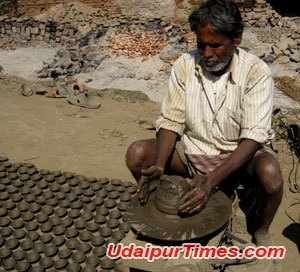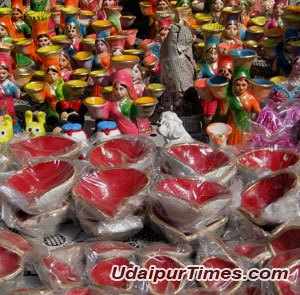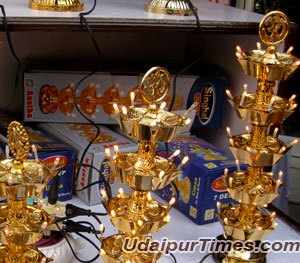Embryonic Story of Diwali Diyas
In Udaipur diyas are made in bulk in ‘Kumharo ka Bhatta’ opposite M.B. College. A person named Munna Lal primarily takes care of the production of Diyas. The image of a potter moving the wheel at an incredible speed and crafting awe-inspiring diyas now has a slight change with the advancement in technology. Electric Chakkas have been introduced which increase the speed of production.
 A walk during the evening hours around any residential area in Udaipur, will testify the same. Understanding this significance, our reporter, tried to gather some basic facts about diyas in Udaipur. In Udaipur diyas are made in bulk in ‘Kumharo ka Bhatta’ opposite M.B. College. A person named Munna Lal primarily takes care of the production of Diyas. The image of a potter moving the wheel at an incredible speed and crafting awe-inspiring diyas now has a slight change with the advancement in technology. Electric Chakkas have been introduced which increase the speed of production. While, with the use of Traditional Chakka around 1000 diyas could be produced in a day, the Electric Chakka can churn out as much as 5000 diyas per day. With high productivity, the costs too have increased. Earlier where one could get 5 diyas for Rs. 1, with this change one gets 10 diyas for Rs. 5. Though, the use of Electric Chakka has begun around 2 years back in Kumharo ka Bhatta, Traditional C hakkas are also used. Production for this year which began with Navratri has now stopped as the season has almost reached its end. Chotulal Prajapat, a shopkeeper at Kumharwada said that he sells almost 1 lakh diyas till the last day of Diwali. It isn’t an unbelievable number, if one has a glance at the number of customers in his shop. And his isn’t the only shop, there are many such shops selling diyas across the length and breadth of Udaipur.
A walk during the evening hours around any residential area in Udaipur, will testify the same. Understanding this significance, our reporter, tried to gather some basic facts about diyas in Udaipur. In Udaipur diyas are made in bulk in ‘Kumharo ka Bhatta’ opposite M.B. College. A person named Munna Lal primarily takes care of the production of Diyas. The image of a potter moving the wheel at an incredible speed and crafting awe-inspiring diyas now has a slight change with the advancement in technology. Electric Chakkas have been introduced which increase the speed of production. While, with the use of Traditional Chakka around 1000 diyas could be produced in a day, the Electric Chakka can churn out as much as 5000 diyas per day. With high productivity, the costs too have increased. Earlier where one could get 5 diyas for Rs. 1, with this change one gets 10 diyas for Rs. 5. Though, the use of Electric Chakka has begun around 2 years back in Kumharo ka Bhatta, Traditional C hakkas are also used. Production for this year which began with Navratri has now stopped as the season has almost reached its end. Chotulal Prajapat, a shopkeeper at Kumharwada said that he sells almost 1 lakh diyas till the last day of Diwali. It isn’t an unbelievable number, if one has a glance at the number of customers in his shop. And his isn’t the only shop, there are many such shops selling diyas across the length and breadth of Udaipur.  There is a change in the demand for diyas amongst customers. Not only has the demand increased in numbers over the years, but the horizons have expanded for shapes and sizes as well. Fancy diyas in a variety of shapes like heart-shaped diyas, leaf-shaped diyas, star-shaped diyas and many more are available to meet the varied tastes. The sellers compete in designs to attract the customers. While these fancy diyas can amount to around Rs. 5 per diya, large size decorative diyas can cost anywhere between Rs. 10 to Rs. 15.
There is a change in the demand for diyas amongst customers. Not only has the demand increased in numbers over the years, but the horizons have expanded for shapes and sizes as well. Fancy diyas in a variety of shapes like heart-shaped diyas, leaf-shaped diyas, star-shaped diyas and many more are available to meet the varied tastes. The sellers compete in designs to attract the customers. While these fancy diyas can amount to around Rs. 5 per diya, large size decorative diyas can cost anywhere between Rs. 10 to Rs. 15.  A comparatively new addition is the ‘Electronic Diya’. These too are available in various shapes and sizes at almost every shop selling diyas. The cost of these diyas ranges between Rs. 60 to Rs. 190 depending on their size and decorative lights. These electronic diyas are manufactured in Delhi and are supplied to local market in Udaipur. Wax Candles is another way of lighting up your Diwali. Amongst all this glitter and shine, one can only hope that people do not forget the true essence and meaning hidden behind the age old ritual of lighting the diyas – inner enlightenment. Happy Diwali!!!
A comparatively new addition is the ‘Electronic Diya’. These too are available in various shapes and sizes at almost every shop selling diyas. The cost of these diyas ranges between Rs. 60 to Rs. 190 depending on their size and decorative lights. These electronic diyas are manufactured in Delhi and are supplied to local market in Udaipur. Wax Candles is another way of lighting up your Diwali. Amongst all this glitter and shine, one can only hope that people do not forget the true essence and meaning hidden behind the age old ritual of lighting the diyas – inner enlightenment. Happy Diwali!!!To join us on Facebook Click Here and Subscribe to UdaipurTimes Broadcast channels on GoogleNews | Telegram | Signal


